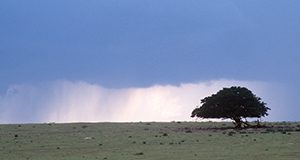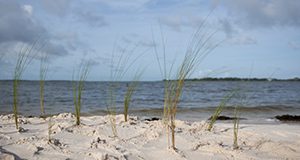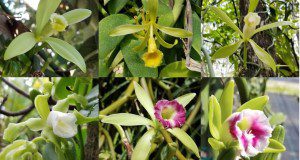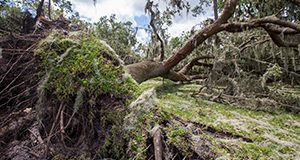Climate is the long-term patterns and fluctuations in air and moisture. This 5-page article explains how future climate is projected using mathematical models and introduces common scientific terms used when discussing climate change. Written by Young Gu Her, Zachary Brym, Ashley Smyth, and Elias Bassil, and published by the UF/IFAS Department of Agricultural and Biological Engineering, November 2020.
https://edis.ifas.ufl.edu/ae546
Tag: Elias Bassil
How Are Our Future Agriculture and Natural Resources Projected under Varying Climate?
This 8-page article explains how agriculture and natural resources may respond to projected future climate and how climate projections can be useful in developing management plans for the improved sustainability of Florida's agriculture and natural resources. It also aims to help increase the public awareness of climate change impacts on Florida and improve understanding of the connections among climate, agriculture, and natural resources. Written by Young Gu Her, Ashley Smyth, Zachary Brym, and Elias Bassil, and published by the UF/IFAS Department of Agricultural and Biological Engineering, September 2020.
https://edis.ifas.ufl.edu/ae545
Online Sources for Sea Level Rise Education and Extension
The impacts of sea level rise on ecosystems and natural resources are a major concern in Florida, especially in low-lying coastal areas such as south Florida. Sea level rise can impact many aspects of Florida's economy, including urban development, agriculture, infrastructure, and natural areas. This 16-page document introduces, evaluates, and summarizes selected available online sources and tools to educate diverse stakeholders and concerned local residents on important aspects of sea level rise. Written by Young Gu Her, Ashley Smyth, Jiangxiao Qiu, Elias Bassil, Ulrich Stingl, and Laura Reynolds, and published by the UF/IFAS Department of Agricultural and Biological Engineering, June 2020.
https://edis.ifas.ufl.edu/ae543
Culture de la vanille dans le sud de la Floride
L’extrait de vanille est populaire dans le monde entier comme ingrédient dans la crème glacée et divers autres desserts. La source botanique de l’extrait de vanille provient principalement des gousses durcies (préparées) de l’espèce Vanilla planifolia. Les États-Unis sont les plus grands importateurs mondiaux de gousses de vanille, mais la production nationale est très faible. Toutefois, le sud de la Floride a un potentiel de production favorable á la culture de la vanille. Ce document contient des informations utiles aux producteurs intéressés par l’établissement d’une vanillerie.
This is the French version of HS1348, Vanilla Cultivation in Southern Florida. This new 9-page publication was written by Alan Chambers, Pamela Moon, Vovener de Verlands Edmond, and Elias Bassil, translated by Francesca Carla Erié, and published by the UF/IFAS Horticultural Sciences Department.
https://edis.ifas.ufl.edu/hs1351
Cultivo de vainilla en el sur de Florida
El extracto de vainilla es popular en el mundo entero como un ingrediente usado en helados y otros postres. La fuente botánica del extracto de vainilla es principalmente los frijoles curados de Vanilla planifolia. El Estados Unidos es el mayor importador mundial de vainilla judías, pero la producción nacional es mínima. El sur de la Florida tiene un clima de crecimiento favorable para el cultivo de vainilla. Este documento incluye información relevante para los productores interesados en establecer un cultivo de vainilla.
This is the Spanish version of HS1348, Vanilla Cultivation in Southern Florida. This new 8-page publication was written by Alan Chambers, Pamela Moon, Vovener de Verlands Edmond, and Elias Bassil, translated by Dayana Valdes, and published by the UF/IFAS Horticultural Sciences Department.
https://edis.ifas.ufl.edu/hs1350
Vanilla Cultivation in Southern Florida
Vanilla extract is popular around the world as an ingredient in ice cream and various other desserts. The botanical source of vanilla extract is primarily the cured beans of Vanilla planifolia. The United States is the world’s largest importer of vanilla beans, but domestic production is minimal. However, southern Florida has a favorable growing environment for vanilla cultivation. This new 7-page publication of the UF/IFAS Horticultural Sciences Department includes information relevant to growers interested in establishing a vanillery. Written by Alan H. Chambers, Pamela Moon, Vovener de Verlands Edmond, and Elias Bassil.
https://edis.ifas.ufl.edu/hs1348
Hurricane Impacts on Florida's Agriculture and Natural Resources
Hurricanes are capable of affecting almost everything in their paths. Their strong winds and heavy rains can directly impact both inland and coastal areas in short periods that usually last about a day. This new 10-page document reviews basic facts about hurricanes and their effects in Florida and discusses ways they might affect Florida's agriculture and natural resources. Written by Young Gu Her, Ashley Smyth, Pamela Fletcher, Elias Bassil, Ulrich Stingl, Zachary Brym, and Jiangxiao Qiu, and published by the UF/IFAS Department of Agricultural and Biological Engineering, October 2018.
http://edis.ifas.ufl.edu/ae528



